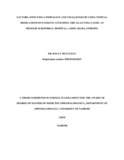| dc.contributor.author | Mulugeta, Belay | |
| dc.date.accessioned | 2019-01-30T05:43:41Z | |
| dc.date.available | 2019-01-30T05:43:41Z | |
| dc.date.issued | 2018 | |
| dc.identifier.uri | http://hdl.handle.net/11295/105923 | |
| dc.description.abstract | Background: In ophthalmology, non-compliance with eye drop therapy particularly for chronic diseases like glaucoma is a well-recognized problem, with 80% of the patients administering their own eye drops using various techniques and methods. Glaucoma is mostly asymptomatic. Non-compliance and difficulties associated with use of glaucoma eye drops can potentially result in treatment failure. There is limited understanding of the challenges these patients face in Ethiopia.
Objective: To determine factors affecting compliance and the challenges of using topical medications in patients attending the glaucoma clinic at Menelik II Referral Hospital.
Study Design: Hospital based cross-sectional study
Study Population: The study included all patients ≥18 years with open angle glaucoma on medication who had at least 6 months of experience with topical glaucoma medications use and visited the hospital during the study period (March 2017 to 3rd July /2018).
Data collection: Participants were interviewed about their knowledge, frequency and pattern of eye drop use to determine their level of compliance, they were interviewed to describe the difficulties experienced when using drops; and finally, they were observed while applying eye drops using artificial tears to determine the appropriateness of their technique. Data on any co-morbidities which may affect eye drop application was also collected. Eye drop practice was further explored in focus group discussion with patients and care givers (pharmacist, residents, ophthalmic nurse and glaucoma specialist) separately.
Non-compliance was defined as missing at least one drop application in the past week.
ix
Results: 198 participants were analyzed. Most (81.3%) patients reported using medications as prescribed but by definition only 69.7% were compliant. The main reasons for non-compliance were forgetfulness (59.5%), unavailability of drops in the pharmacy (10.8%) and financial problem (8.1%). Inappropriate drop application technique was observed often.
Conclusion: The compliance to medication was low mainly due to dose forgetfulness. The socio-demographic characteristics did not affect compliance. Patients using eye drops as instructed were found compliant to treatment. | en_US |
| dc.language.iso | en | en_US |
| dc.publisher | University of Nairobi | en_US |
| dc.rights | Attribution-NonCommercial-NoDerivs 3.0 United States | * |
| dc.rights.uri | http://creativecommons.org/licenses/by-nc-nd/3.0/us/ | * |
| dc.subject | Factors Affecting Compliance and Challenges in Using Topical Medications in Patients | en_US |
| dc.title | Factors Affecting Compliance and Challenges in Using Topical Medications in Patients Attending the Glaucoma Clinic at Menelik Ii Referral Hospital, Addis Ababa, Ethiopia | en_US |
| dc.type | Thesis | en_US |
| dc.description.department | a
Department of Psychiatry, University of Nairobi, ; bDepartment of Mental Health, School of Medicine,
Moi University, Eldoret, Kenya | |



